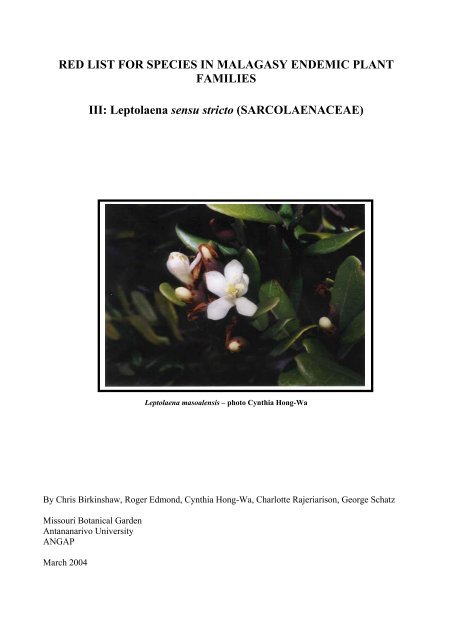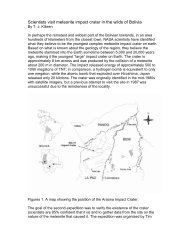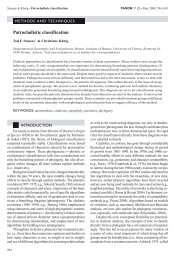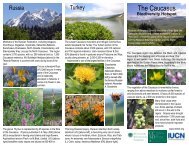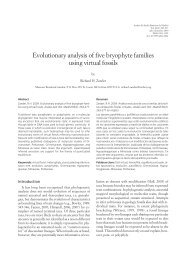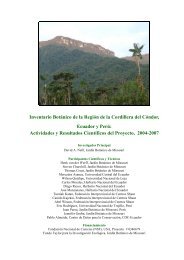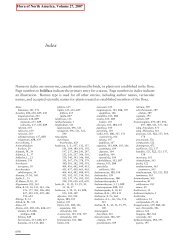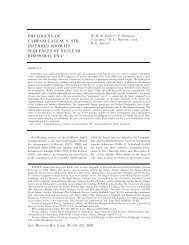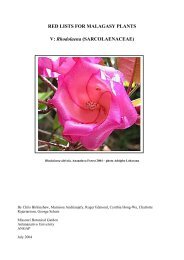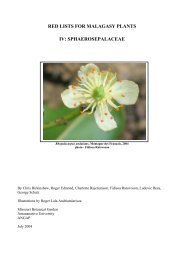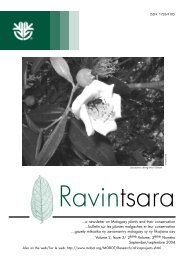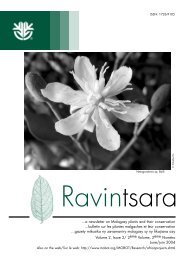red list for species in malagasy endemic plant - Missouri Botanical ...
red list for species in malagasy endemic plant - Missouri Botanical ...
red list for species in malagasy endemic plant - Missouri Botanical ...
You also want an ePaper? Increase the reach of your titles
YUMPU automatically turns print PDFs into web optimized ePapers that Google loves.
RED LIST FOR SPECIES IN MALAGASY ENDEMIC PLANT<br />
FAMILIES<br />
III: Leptolaena sensu stricto (SARCOLAENACEAE)<br />
Leptolaena masoalensis – photo Cynthia Hong-Wa<br />
By Chris Birk<strong>in</strong>shaw, Roger Edmond, Cynthia Hong-Wa, Charlotte Rajeriarison, George Schatz<br />
<strong>Missouri</strong> <strong>Botanical</strong> Garden<br />
Antananarivo University<br />
ANGAP<br />
March 2004
Introduction<br />
Nowhere <strong>in</strong> the World can rival Madagascar <strong>in</strong> terms of the diversity and uniqueness of its flora.<br />
Estimates of the total number of <strong>plant</strong> <strong>species</strong> <strong>in</strong> the country cont<strong>in</strong>ue to climb and now it is thought<br />
that at least 13,000 <strong>species</strong> of higher <strong>plant</strong> grow <strong>in</strong> the country (pers. comm. P. Phillipson). This<br />
remarkable diversity is especially important given that nearly all these <strong>species</strong> (around 90% - Schatz<br />
1999) grow only <strong>in</strong> Madagascar. Sadly Madagascar’s exceptional flora is highly threatened and an<br />
alarm<strong>in</strong>g number of <strong>plant</strong> <strong>species</strong> are now on the very br<strong>in</strong>k of ext<strong>in</strong>ction. We must now choose<br />
whether to make strenuous ef<strong>for</strong>ts to conserve the Malagasy flora or accept, with<strong>in</strong> the next few<br />
decades, the loss of a large number of <strong>plant</strong> <strong>species</strong>. Now is the last chance to make this choice.<br />
An important part of effective conservation is prioritization: the relatively small amount of money<br />
available <strong>for</strong> conservation must be used where it will have most impact. To assist with the<br />
prioritization of conservation actions <strong>for</strong> the Malagasy flora a series of documents will be produced<br />
conta<strong>in</strong><strong>in</strong>g risk of ext<strong>in</strong>ction estimates <strong>for</strong> <strong>species</strong> <strong>in</strong> selected Malagasy <strong>plant</strong> families.<br />
The research presented here was conducted as a collaborative project between <strong>Missouri</strong> <strong>Botanical</strong><br />
Garden (MBG), Antananarivo University and Madagascar’s National Association <strong>for</strong> the<br />
Management of Protected Areas (ANGAP).<br />
Methods <strong>for</strong> estimat<strong>in</strong>g risk of ext<strong>in</strong>ction<br />
The identification of the <strong>species</strong> with the highest priority <strong>for</strong> conservation action is based on<br />
estimates of their likelihood of becom<strong>in</strong>g ext<strong>in</strong>ct <strong>in</strong> the next few decades. However be<strong>for</strong>e the risk<br />
of ext<strong>in</strong>ction of a <strong>species</strong> can be <strong>in</strong>vestigated it is necessary to ensure that it has been delimited<br />
us<strong>in</strong>g a taxonomic framework that closely reflects the real distribution of variation (that <strong>in</strong> turn<br />
reflects underly<strong>in</strong>g evolutionary history) with<strong>in</strong> the genus/family to which the <strong>species</strong> belongs. In<br />
an endeavor associated with our study the taxonomic framework of each of Madagascar’s <strong>endemic</strong><br />
families was exam<strong>in</strong>ed by scientists from <strong>Missouri</strong> <strong>Botanical</strong> Garden and the National Museum of<br />
Natural History <strong>in</strong> Paris .and those judged <strong>in</strong>adequate were revised. These revisions were published<br />
as a series of articles <strong>in</strong> the journal Adansonia and resulted <strong>in</strong> new <strong>species</strong> be<strong>in</strong>g delimited,<br />
previously recognized <strong>species</strong> be<strong>in</strong>g re-circumscribed, and others placed <strong>in</strong> synonymy.<br />
In<strong>for</strong>mation on the risk of ext<strong>in</strong>ction of each <strong>species</strong> was obta<strong>in</strong>ed from the analysis of its<br />
distribution and from observations made <strong>in</strong> the field. Most of this work was conducted by<br />
Malagasy students as part of their DEA (= Masters) studies. Species distribution was estimated<br />
us<strong>in</strong>g geo-referenced locality data obta<strong>in</strong>ed from herbarium specimens <strong>in</strong> the five herbaria (K, MO,<br />
P, TAN, TEF) with large hold<strong>in</strong>gs of Malagasy <strong>plant</strong>s. Most recent herbarium specimens <strong>in</strong>clude<br />
precise longitude and latitude coord<strong>in</strong>ates of the collection location obta<strong>in</strong>ed us<strong>in</strong>g a GPS, but many<br />
older specimens do not, necessitat<strong>in</strong>g post facto allocation of coord<strong>in</strong>ates by locat<strong>in</strong>g the collection<br />
site on maps with the aid of MBG’s Madagascar gazetteer (available on l<strong>in</strong>e at<br />
(http://www.mobot.org/MOBOT/Research/madagascar/gazetteer). The collection sites were<br />
mapped and analyzed us<strong>in</strong>g ArcView Geographic In<strong>for</strong>mation System (GIS) software. The<br />
resultant <strong>species</strong> distribution was quantified <strong>in</strong> terms of extent of occurrence, area of occupancy,<br />
and number of subpopulations. The analysis of each <strong>species</strong>’ distribution <strong>in</strong> relation to various<br />
environmental base maps provided <strong>in</strong><strong>for</strong>mation on the habitat of the <strong>species</strong> <strong>in</strong> terms of geology,<br />
vegetation type, bioclimate and elevation.<br />
In<strong>for</strong>mation on the habitat, abundance, poll<strong>in</strong>ation, seed dispersal, regeneration, threats, uses and<br />
vernacular name <strong>for</strong> each <strong>species</strong> was obta<strong>in</strong>ed by locat<strong>in</strong>g and study<strong>in</strong>g at least one population <strong>in</strong>
the wild. The best method of locat<strong>in</strong>g <strong>species</strong> proved to be with the assistance of local people liv<strong>in</strong>g<br />
close to previous collection sites. In<strong>for</strong>mation on the vernacular name and uses of the <strong>species</strong> were<br />
also obta<strong>in</strong>ed from the labels of herbarium specimens.<br />
Further <strong>in</strong><strong>for</strong>mation on the methods used <strong>in</strong> the study are provided <strong>in</strong> Table 1.<br />
The <strong>in</strong><strong>for</strong>mation collected <strong>for</strong> each <strong>species</strong> is summarized <strong>in</strong> a Risk of Ext<strong>in</strong>ction Datasheet
Table 1. Methods <strong>for</strong> the collection of <strong>in</strong><strong>for</strong>mation presented <strong>in</strong> each of the data fields of the Species<br />
Conservation Priority Datasheet.<br />
Species name and author: name of <strong>species</strong> accord<strong>in</strong>g to the most recent<br />
taxonomic revision and name of author(s) who def<strong>in</strong>ed the <strong>species</strong><br />
Vernacular names: from <strong>in</strong><strong>for</strong>mation collected <strong>in</strong> the field and captu<strong>red</strong><br />
from herbarium specimens.<br />
Description: based on <strong>in</strong><strong>for</strong>mation <strong>in</strong> the literature and our own<br />
observations of herbarium specimens and liv<strong>in</strong>g <strong>plant</strong>s <strong>in</strong> the field.<br />
Habitat:<br />
• Vegetation type: def<strong>in</strong>ed by observations <strong>in</strong> the field and analysis of the<br />
distribution of the <strong>species</strong> related to the vegetation map of DuPuy &<br />
Moat (1996)<br />
• Bioclimate: def<strong>in</strong>ed by the analysis of the distribution of the <strong>species</strong><br />
related to the bioclimate map of Cornet (1974)<br />
• Geology: def<strong>in</strong>ed by observations <strong>in</strong> the field and analysis of the<br />
distribution of the <strong>species</strong> related to the geology map of DuPuy & Moat<br />
(1996)<br />
• Altitude: based on field observations and <strong>in</strong><strong>for</strong>mation captu<strong>red</strong> from the<br />
notes accompany<strong>in</strong>g herbarium specimens<br />
Biology:<br />
• Poll<strong>in</strong>ation: probable poll<strong>in</strong>ator identified from characteristics of flower<br />
and observations <strong>in</strong> the field<br />
• Seed dispersal: probable method of seed dispersal identified from<br />
characteristics of fruit and observations <strong>in</strong> the field<br />
Uses: based on <strong>in</strong><strong>for</strong>mation collected by <strong>in</strong>terview<strong>in</strong>g local people <strong>in</strong> the<br />
field and captu<strong>red</strong> from the literature and notes on herbarium specimens.<br />
Distribution: distribution of the <strong>species</strong> represented by the<br />
locations of the collection sites of the herbarium specimens<br />
attributed to the <strong>species</strong> <strong>in</strong> the five herbaria with large<br />
collections from Madagascar. Map created us<strong>in</strong>g Arcview<br />
3.2 software.<br />
Herbarium specimens exam<strong>in</strong>ed: <strong>list</strong> of herbarium specimens exam<strong>in</strong>ed <strong>for</strong> this study<br />
Risk of ext<strong>in</strong>ction: based on the application of criteria presented<br />
<strong>in</strong> IUCN (2001)<br />
Conservation recommendations: our recommendations <strong>for</strong> actions to <strong>red</strong>uce the<br />
risk of ext<strong>in</strong>ction of the <strong>species</strong>.<br />
Observations of study population(s)<br />
Location: study site with geo-reference<br />
• Regeneration observed: presence of regeneration assumed from the presence at the<br />
site of <strong>in</strong>dividuals representative of all size classes.<br />
• Tolerant to disturbance: presence of regenerat<strong>in</strong>g populations of the <strong>species</strong> <strong>in</strong><br />
severely degraded vegetation ( >50% of orig<strong>in</strong>al biomass lost).<br />
• Density: average number of mature <strong>in</strong>dividuals of the <strong>species</strong> per ha of appropriate<br />
habitat based on counts <strong>in</strong> replicated plots or along transects.<br />
• Abundance: estimated number of mature <strong>in</strong>dividuals at the study site based on the<br />
density of the <strong>species</strong> at the site and an estimate of the area of suitable habitat<br />
available (abundance classes based on thresholds used <strong>in</strong> IUCN (2001).<br />
P<strong>red</strong>icted future decl<strong>in</strong>e:<br />
• Due to habitat loss: estimate of decl<strong>in</strong>e of population based on observations of<br />
tolerance of <strong>species</strong> to habitat perturbation and estimates of rate of loss of primary<br />
vegetation from (FAO 1993, Green & Sussman 1990, Ste<strong>in</strong><strong>in</strong>ger et al. 2002).<br />
Classes of population decl<strong>in</strong>e (i.e. 0-30%, ≥30-50%, ≥50-80%, ≥80%) relate to<br />
thresholds used <strong>in</strong> the IUCN (2001).<br />
• Due to exploitation or poor regeneration: <strong>in</strong> addition to loss of habitat it is possible<br />
that populations may decl<strong>in</strong>e because of selective exploitation or poor regeneration<br />
result<strong>in</strong>g <strong>for</strong> example from the <strong>in</strong>creas<strong>in</strong>g rarity of poll<strong>in</strong>ators or seed dispersers.<br />
Although we were unable to quantify these factors, their possible significance is<br />
noted.<br />
Distribution attributes <strong>for</strong> total population:<br />
(These analyses made us<strong>in</strong>g ArcVeiw 3.2)<br />
• Extent of occurrence: estimated as the area conta<strong>in</strong>ed with<strong>in</strong> the shortest<br />
cont<strong>in</strong>uous imag<strong>in</strong>ary boundary drawn to encompass all the collection locations <strong>for</strong><br />
the <strong>species</strong>.<br />
• Area of occupancy: estimated as the area of suitable habitat (def<strong>in</strong>ed <strong>in</strong> terms of<br />
vegetation type, bioclimate, altitude and geology) <strong>for</strong> the <strong>species</strong> with<strong>in</strong> the extent<br />
of occurrence.<br />
• Number of subpopulations: estimated as the number of collection locations but<br />
comb<strong>in</strong><strong>in</strong>g locations that are separated by less than 5 km.<br />
Representation <strong>in</strong> protected areas:<br />
Protected areas are def<strong>in</strong>ed as National Parks (PN), Special Reserves (RS), Nature<br />
Reserves (RNI), Biosphere Reserves (RB).<br />
• Number of subpopulations: number of data po<strong>in</strong>ts with<strong>in</strong> protected areas but<br />
comb<strong>in</strong><strong>in</strong>g locations separated by less than 5 km.<br />
• Protected areas: <strong>list</strong> of protected areas where the <strong>species</strong> has been recorded.
Endemic family with 8 genera and ca. 44 <strong>species</strong>.<br />
Sarcolaenaceae Caruel<br />
(from Schatz 2001)<br />
Hermaphrodite shrubs to large trees, often with stellate pubescence. Leaves alternate, simple,<br />
entire, penn<strong>in</strong>erved or rarely pseudo-tripl<strong>in</strong>erved by virtue of <strong>in</strong>duplicate vernation traces, with<br />
caducous stipules. Inflorescences umbelli<strong>for</strong>m or paniculate cymes, <strong>for</strong> sometimes flowers solitary,<br />
flowers small to often large and showy, regular, 5-merous, subtended by an <strong>in</strong>volucre of bracts<br />
wich are sometimes fused to <strong>for</strong>m a cup; sepals 3 (-5), imbricate; petals 5 (-6), free, or slightly fused<br />
at their base, twisted <strong>in</strong> bud; nectary disc present or not; stamens 5-numerous, sometimes slightly<br />
fused at their base <strong>in</strong>to 5 fascicles, filaments slender, anthers bilocular, longitud<strong>in</strong>ally dehiscent;<br />
ovary superior, 1-5-locular, style term<strong>in</strong>al, stigma 3-5-lobed; ovules 2-many per locule. Fruit a<br />
dehiscent capsule or <strong>in</strong>dehiscent and somewhat woody, often surrounded partially or completely by<br />
the <strong>in</strong>volucral bracts or cup; endosperm present.<br />
Key to genera of Sarcolaenaceae<br />
1. Leaves with longitud<strong>in</strong>al l<strong>in</strong>es (vernation traces) on either side of the midrib as a result of fold<strong>in</strong>g <strong>in</strong> bud,<br />
resembl<strong>in</strong>g ve<strong>in</strong>s and thus the venation superficially tripl<strong>in</strong>erved to 3-palmat<strong>in</strong>erved, rarely the traces absent<br />
(S. isaloensis) ......................................................................................................................Sarcolaena<br />
1'. Leaves lack<strong>in</strong>g vernation traces on either side of the midrib, never superficially tripl<strong>in</strong>erved or palmat<strong>in</strong>erved.<br />
2. Leaves with mixture of stellate and lepidote <strong>in</strong>dument, often dense; <strong>in</strong>volucre very small at anthesis, very late<br />
accrescent <strong>in</strong> fruit or not at all.<br />
3. Fruit <strong>in</strong>dehiscent, surrounded by accrescent, entire <strong>in</strong>volucre; ovary 2-locular ................Perrierodendron<br />
3'. Fruit dehiscent, the <strong>in</strong>volucre accrescent or not, lobed; ovary 3-5-locular.<br />
4. Sepals strongly unequal, the outer 2 much smaller; petals strongly contorted <strong>in</strong> bud; ovary 3-locular;<br />
ovules 2 per locule ..................................................................................................Eremolaena<br />
4'. Sepals more or less equal; petals slightly contorted <strong>in</strong> bud; ovary 5-locular; ovules 4-6 per locule<br />
................................................................................................................................Pentachlaena<br />
2'. Leaves glabrous or with simple <strong>in</strong>dument; <strong>in</strong>volucre well-developed at anthesis or not, accrescent <strong>in</strong> fruit.<br />
5. Flowers with <strong>in</strong>volucre well-developed at anthesis, deeply cup- or urn-shaped, partially or completely<br />
enclos<strong>in</strong>g the flower <strong>in</strong> bud.<br />
6. Involucre only partially enclos<strong>in</strong>g the flower <strong>in</strong> bud; stamens arranged <strong>in</strong> 5 fascicles; ovules many per<br />
locule; <strong>in</strong>volucre <strong>in</strong> fruit very large, bell-like, woody, narrowly ellipsoid, thick-walled, with a circular<br />
open<strong>in</strong>g at the apex, the fruit at the base .................................................................Xyloolaena<br />
6'. Involucre completely enclos<strong>in</strong>g the flower <strong>in</strong> bud; stamens not <strong>in</strong> fascicles; ovules 2 (-4) per locule;<br />
<strong>in</strong>volucre only slightly accrescent <strong>in</strong> fruit, not thick walled and bell-like with the fruit at the base<br />
................................................................................................................................Leptolaena (and<br />
Sarcolaena isaloensis)<br />
5'. Flowers with <strong>in</strong>volucre small at anthesis, not deeply cup- or urnshaped and partially or completely<br />
enclos<strong>in</strong>g the flower.<br />
7. Sepals 5, the outer 2 smaller; flowers large, pendulous, the petals showy p<strong>in</strong>k-violet <strong>for</strong>m<strong>in</strong>g a funnelshaped<br />
corolla; <strong>in</strong>volucre late accrescent <strong>in</strong> fruit, fleshy but not viscous, lobed but never sp<strong>in</strong>y<br />
................................................................................................................................Rhodolaena<br />
7'. Sepals 3; flowers small to large, petals white to cream-yellow, rarely p<strong>in</strong>k, spread<strong>in</strong>g, not <strong>for</strong>m<strong>in</strong>g a<br />
funnel-shaped corolla; <strong>in</strong>volucre strongly accrescent <strong>in</strong> fruit, viscous and fleshy, entire or lac<strong>in</strong>iate or<br />
with fleshy sp<strong>in</strong>es....................................................................................................Schizolaena
Leptolaena Thouars, Hist. Vég. Iles Austrl. Afriq.: 41. 1805.<br />
Shrubs to trees to 15 tall. Leaves often quite small, stipules fused or free, visible only on very<br />
young branches, cover<strong>in</strong>g the term<strong>in</strong>al bud. Inflorescences term<strong>in</strong>al cymes or panicles, flowers<br />
small; <strong>in</strong>volucre well-developed, cup-like, completely envelop<strong>in</strong>g the flower <strong>in</strong> bud, the rim<br />
toothed, becom<strong>in</strong>g fleshy to woody <strong>in</strong> fruit; sepals 3, persistent; petals 5, white; disc annular with<br />
toothed to crenulate marg<strong>in</strong>; stamens 10 (-15) to numerous; ovary 3-5-locular, style dist<strong>in</strong>ct, stigma<br />
3-5-lobed; ovules 2-3 per locule. Fruit tardily dehiscent 3-lobed capsule surrounded by fleshy to<br />
woody accrescent <strong>in</strong>volucre, with 1-3 seeds per locule.<br />
Leptolaena is distributed <strong>in</strong> humid to subhumid evergreen <strong>for</strong>est <strong>in</strong>clud<strong>in</strong>g the Sambirano region,<br />
from sea level to 1,500 m elevation, as well as dry semi-deciduous <strong>for</strong>est from the Ambongo-Bo<strong>in</strong>a<br />
region northwards. It is very closely related to Sarcolaena, with which it could well be merged. In<br />
general, Leptolaena can be dist<strong>in</strong>guished from Sarcolaena by smaller leaves that lack vernation<br />
traces, smaller flowers, and a drier, more woody <strong>in</strong>volucre <strong>in</strong> fruit.<br />
Vernacular names: aman<strong>in</strong>ombilahy, aman<strong>in</strong>ombilahy mena, anivorav<strong>in</strong>a, anjananjana, dilatra,<br />
fonto, fontona, foto, fotona, fotonalahy, fotondahy, haronganipanihy, hary, hazomasy, helana,<br />
kotika, laro, madiorano, marosirala, milaliambomad<strong>in</strong>ika, sarifatra, taimbarika, vandroza,<br />
vandrozana, vatsikana, voalaro, vondrozo, zahana, zana, zanalahy<br />
Leptolaena sensu stricto.<br />
Currently, the taxonomic framework <strong>for</strong> the Leptolaena-Sarcolaena complex is confused and<br />
<strong>species</strong> currently classified with<strong>in</strong> Leptolaena sensu lato (as def<strong>in</strong>ed by Cavaco 1952a, b) are<br />
probably polyphyletic. However, with<strong>in</strong> this taxa a sub-group of 8 <strong>species</strong>, classified <strong>in</strong> Leptolaena<br />
sensu stricto, are almost certa<strong>in</strong>ly monophyletic and have been made the subject of a recent<br />
taxonomic revision (Schatz et al. 2001): it is these that are <strong>in</strong>cluded <strong>in</strong> this Red List treatment. An<br />
estimation of the risk of ext<strong>in</strong>ction of the rema<strong>in</strong><strong>in</strong>g <strong>species</strong> currently classified as Leptolaena s.l.<br />
will be made once their taxonomy has been clarified.<br />
Species with<strong>in</strong> Leptolaena s.s. differ from other <strong>species</strong> of Leptolaena s.l. by their smaller flowers<br />
and smaller number of stamens.
Key to <strong>species</strong> of Leptolaena sensu stricto<br />
(from Schatz et al. 2001)<br />
1. Leaves small, the largest blades usually < 2 cm long (occasionally to 4.5 cm), broadly ovate to circular or rhombic;<br />
<strong>in</strong>florescences composed of 1-5 flowers..............................................................................................L. pauciflora<br />
1’. Leaves larger, the largest blade > 3 cm long, lanceolate, obovate or narrowly to broadly ovate or elliptic;<br />
<strong>in</strong>florescences composed of 7-50 flowers (2-8 L. masoalensis) ..........................................................2<br />
2. Leaf apex obtuse to rounded, sometimes emarg<strong>in</strong>ated ....................................................................3<br />
2’. Leaf apex acute to acum<strong>in</strong>ate. ........................................................................................................4<br />
3. Involucre urceolate, 3 mm tall, cove<strong>red</strong> with dense granular ferrug<strong>in</strong>ous <strong>in</strong>dumentum ; sepals exerted 1-1.5 mm<br />
beyond <strong>in</strong>volucre; leaves narrowly to broadly elliptic, secondary ve<strong>in</strong>s (8-)11-13 per side................L. delph<strong>in</strong>ensis<br />
3’. Involucre ellipsoid to oblong, 7 mm tall, cove<strong>red</strong> with sparse, short white <strong>in</strong>dumentum ; sepals completely <strong>in</strong>cluded<br />
with<strong>in</strong> <strong>in</strong>volucre; leaves elliptic to slightly obovate, secondary ve<strong>in</strong>s usually 8 per side....................L. masoalensis<br />
4. Leaves sparsely to moderately sericeous below, with both short appressed trichomes and longer slightly raised<br />
trichomes often exceed<strong>in</strong>g 1 mm long (older leaves occasionally subglabrous), marg<strong>in</strong>s dist<strong>in</strong>ctly revolute<br />
.............................................................................................................................................................L. raymondii<br />
4’. Leaves glabrous below or with <strong>in</strong>dumentum restricted to the midve<strong>in</strong>, marg<strong>in</strong>s weakly revolute to flat, sometimes<br />
m<strong>in</strong>utely thickened ..............................................................................................................................5<br />
5. Leaf blades with evident <strong>in</strong>dumentum on the midve<strong>in</strong> below .........................................................6<br />
5’. Leaf blades completely glabrous (rarely a few trichomes at the base of the midve<strong>in</strong> below) ........7<br />
6. Involucre usually < 3 mm tall, densely golden yellow granular far<strong>in</strong>ose, rounded at the base with a dist<strong>in</strong>ct peduncle 1<br />
mm long; petals 7-9 x 1-1.5 mm; leaves lanceolate to ovate, apex dist<strong>in</strong>ctly cuspidate......................L. cuspidata<br />
6’. Involucre 3-3.5 mm tall, densely ferrug<strong>in</strong>ous granular far<strong>in</strong>ose, usually also with slightly erect whitish trichomes 0.5<br />
mm long, especially <strong>in</strong> the lower portion, evenly taper<strong>in</strong>g to a cuneate base, with an <strong>in</strong>dist<strong>in</strong>ct peduncle
Leptolaena cuspidata – photo by Cynthia Hong-Wa Leptolaena masoalensis – photo by Cynthia Hong-Wa<br />
Leptolaena multiflora – photo Cynthia Hong-Wa Leptolaena pauciflora – photo Cynthia Hong-Wa<br />
Leptolaena raymondii – photo Cynthia Hong-Wa Leptolaena cuspidata fruits – photo Cynthia Hong-Wa
RISK OF EXTINCTION DATASHEETS
Leptolaena abrahamii G.E. Schatz & Lowry Risk of ext<strong>in</strong>ction: east Least Concern (although this <strong>species</strong><br />
has a high p<strong>red</strong>icted population decl<strong>in</strong>e it has several large and<br />
apparently secure sub-populations with<strong>in</strong> protected areas).<br />
Vernacular names : Anjananjana berav<strong>in</strong>a Conservation Recommendations: good management of<br />
protected areas<br />
Description:<br />
Medium tree. Leaf small (medium), lanceolate, strongly<br />
falcate, curved, asymmetrical, base acute/obtuse, apex<br />
acum<strong>in</strong>ate/cuspidate, papery, hairless when mature; petiole<br />
glabrous. Inflorescence with 6-23 flowers. Sepals equal to<br />
(or barely exceed) teeth of <strong>in</strong>volucre. Petals pale yellow.<br />
Flower stalk 1-1.5 mm. Fruit ovoid/globose, 2 mm longer<br />
than fleshy <strong>in</strong>volucre.<br />
Habitat<br />
• Vegetation type: mid-elevation evergreen <strong>for</strong>est<br />
• Bioclimate: humid, subhumid<br />
• Geology: basement rock<br />
• Altitude: 800-1,200 m<br />
Biology<br />
• Poll<strong>in</strong>ation: probably <strong>in</strong>sects (bees seen visit<strong>in</strong>g flowers at<br />
Sahamaloto))<br />
• Seed dispersal: probably birds and lemurs (at Sahamaloto<br />
fruits reported to be eaten by various birds (Hypsipetes<br />
madagascariesnsis, Treron australis) and Varecia<br />
variegata).<br />
Uses<br />
Timber (posts and house frames), bark used <strong>for</strong> manufacture<br />
of toaka gasy (alcoholic dr<strong>in</strong>k)<br />
Observations of study population(s):<br />
• Location: Sahamaloto (19°03’11’’S, 48°12’34’’E)<br />
Distribution<br />
• Regeneration observed: yes<br />
• Tolerant to disturbance: no<br />
• Abundance: 2,500-10,000 mature <strong>in</strong>dividuals<br />
P<strong>red</strong>icted future decl<strong>in</strong>e:<br />
• due to habitat loss : 50-80% (cause of loss = tavy)<br />
• because of exploitation or poor regeneration: decl<strong>in</strong>e possible<br />
because of selective exploitation <strong>for</strong> timber and <strong>red</strong>uction <strong>in</strong><br />
populations of possible seed dispersers and selective<br />
exploitation.<br />
Distribution attributes <strong>for</strong> total population:<br />
• Extent of occurrence: 10,080 km²<br />
• Area of occupancy: 3,329 km²<br />
• Number of subpopulations: 14<br />
Representation <strong>in</strong> protected areas:<br />
• Number of subpopulations: 3<br />
• Protected areas: Analamazaotra RS, Zahamena PN,<br />
Ranomafana PN<br />
Herbarium specimens exam<strong>in</strong>ed: Fianarantsoa: Ranomafana PN, SF(Rahahova) 14241, Ampas<strong>in</strong>ambo, SF 13718, Toamas<strong>in</strong>a: Ampasimpotsy,<br />
SF(Ratovoarison) 3497, Analamazaotra-Pér<strong>in</strong>et RS, Mamisoa N. Andrianjafy & Y.F. Razaf<strong>in</strong>drakoto 28, Analamazaotra-Per<strong>in</strong>et RS, James S. Miller, J.<br />
Brad<strong>for</strong>d, F. Rakotonasolo & A. Randrianasolo 8746, Farizana, SF(Pa<strong>in</strong>a) 5070 Per<strong>in</strong>et-Analamazaotra RS, SF(Ratovoarison) 14959, Per<strong>in</strong>et-Analamazaotra<br />
RS, SF(Ramaroson,A.) 6242, Sandrangato, SF(Rabenaivo,G.R.) 25441, Per<strong>in</strong>et-Analamazaotra RS, SF(Sampana,J.P.) 7564, [Sandrangato, SF(Ranaivojaona,N.)<br />
21898, Sandrangato, SF(Abraham) 21955, Per<strong>in</strong>et-Analamazaotra RS, SF(Station <strong>for</strong>estière d'Analamazaotra) 21244 , Antsahapandrano, SF(Ratovoarison)<br />
21282, Analamazaotra-Per<strong>in</strong>et RS, SF(Razafimandimby,M.) 10348, Ambatovy, Gordon McPherson 17523, Pér<strong>in</strong>et-Analamazoatra, G.E. Schatz & J.<br />
Rabenantoandro 3991, Pér<strong>in</strong>et-Analamazoatra, G.E. Schatz 3993, Analamazaotra-Per<strong>in</strong>et RS, M. Louvel 33, Ambatovy, Ph. Morat 3218, Zahamena RNI,<br />
RN(Botoal<strong>in</strong>a) 12684, Analamazaotra-Per<strong>in</strong>et RS, RN(Goulbert Andrianavo) 15, Analamazaotra-Per<strong>in</strong>et RS, SF 7509,Analamazaotra-Per<strong>in</strong>et RS, SF 3773,<br />
Nangarana, SF(9-R-FAO) 26927, Nangarana, SF(50-R-FAO) 26968, Analamazaotra-Per<strong>in</strong>et RS, R. Viguier & H. Humbert 851, Analamazaotra-Per<strong>in</strong>et RS, H.<br />
Perrier de la Bâthie 5336, Zahamena RNI, RN(Botoal<strong>in</strong>a) 3169, Pér<strong>in</strong>et-Anamalazaotra RS, Mabberley 813, Pér<strong>in</strong>et-Analamazaotra RS, SF 17932, Zahamena<br />
RNI, SF 26096, Zahamena RNI, RN (Laibosaka) 10953, Analamazaotra-Pér<strong>in</strong>et RS, SF(A. Fauchère) 12,, Bema<strong>in</strong>ty, G. Cours 4230, Nonokambo, (G. Cours)<br />
1206, Analamazaotra-Pér<strong>in</strong>et RS, E. Thouvenot (Ramanantoavolana) 12, Analamazaotra-Pér<strong>in</strong>et RS, SF(Ratovoarison F. d'Assise) 124-B-R-172<br />
Analamazaotra-Pér<strong>in</strong>et RS, SF(Ratovoarison F. d'Assise) 105-B-R-172, Zahamena, N.M. Andrianjafy et al. 255.
Leptolaena cuspidata Baker Risk of ext<strong>in</strong>ction: Least Concern (although this <strong>species</strong> is<br />
expected to decl<strong>in</strong>e it has several large and apparently secure<br />
sub-populations with<strong>in</strong> protected areas it is also somewhat<br />
tolerant to degradation of its habitat).<br />
Vernacular names : Zahana Conservation Recommendations: good management of<br />
protected areas<br />
Description:<br />
Shrub or small tree. Leaf small, lanceolate/ovale with<br />
rounded base and long cuspidate apex, papery, hairless at<br />
maturity, mid-rib evident on lower surface and cove<strong>red</strong> with<br />
small brown hairs, petiole hairy. Inflorescence with 14-27<br />
flowers. Flower stalk 1 mm. Involucre < 3 mm long, urnshaped,<br />
cove<strong>red</strong> with yellowish powder. Sepals exceed<br />
<strong>in</strong>volucre by 2 mm. Petals greenish white. Fruit ovoid and<br />
exceed<strong>in</strong>g fleshy <strong>in</strong>volucre by 1.5 mm.<br />
Habitat<br />
• Vegetation type: low-elevation evergreen <strong>for</strong>est, dry<br />
deciduous <strong>for</strong>est<br />
• Bioclimate: subhumid, dry<br />
• Geology: sandstone, lava, basement rocks, Mesozoic<br />
limestone, unconsolidated sands, alluvial and lake deposits<br />
• Altitude: 20-800 m<br />
Biology<br />
• Poll<strong>in</strong>ation: probably <strong>in</strong>sects (bees, beetles and butterflies<br />
seen visit<strong>in</strong>g the flowers at Analavory)<br />
• Seed dispersal: probably birds and lemurs (Hypsipetes<br />
madagascariensis, Treron australis and Eulemur macaco<br />
reported to eat fruit at Analavory)<br />
Uses<br />
Timber <strong>for</strong> construction, bark and leaves used <strong>for</strong> medic<strong>in</strong>e<br />
Distribution<br />
Observations of study population(s):<br />
• Location: Analavory (13°45’36’’S, 48°31’40’’E)<br />
• Regeneration observed: yes<br />
• Tolerant to disturbance: yes<br />
• Abundance: >10,000 mature <strong>in</strong>dividuals<br />
P<strong>red</strong>icted future decl<strong>in</strong>e:<br />
• because of habitat loss: 30-50% (cause of habitat loss = tavy)<br />
• because of exploitation or poor regeneration: decl<strong>in</strong>e possible<br />
because of <strong>in</strong>creas<strong>in</strong>g rarity of vertebrate dispersers and<br />
selective exploitation.<br />
Distribution attributes <strong>for</strong> total population:<br />
• Extent of occurrence: 12.319 km²<br />
• Area of occupancy: 2.571 km²<br />
• Number of subpopulations: 21<br />
Representation <strong>in</strong> protected areas:<br />
• Number of subpopulations: 3<br />
• Protected areas: Ankaranana RS, Manongarivo RS,<br />
Tsaratanana RNI<br />
Herbarium specimens exam<strong>in</strong>ed: Antsiranana: Antsatsaka, Chris Birk<strong>in</strong>shaw 1, Beramanja, Pete Phillipson 2017, Beramanja, SF(R. Capuron) 3078,<br />
Andilamboay, SF(Gachet) 3142, Tsaratanana RNI, SF(Gachet) 3171, Anjakely, SF(Petit-Marie,J.) 8225, Ambilobe, SF(Marohav<strong>in</strong>a) 10434, Manongarivo RS,<br />
SF(R. Capuron) 11486, Manongarivo RS, P. Derleth 89, Manongarivo RS, S. Totozafy Be 563, Ambato FC, H. Ravololonanahary et al. 37, Ampas<strong>in</strong>dava, J.<br />
Bosser 20152, Ambilobe, SERVICE FORESTIER 36016, Ambanja, R. Randrianaivo et al. 261, Ambohipiraka, H. Humbert & G. Cours 32873, Anjakely, SF<br />
12987 Ambohipiraka, G. Cours & H. Humbert 5674, Ambilobe, H. Humbert & R. Capuron 25580, Ankarana RS, H. Humbert & G. Cours 32649,<br />
Ambohipiraka, H. Perrier de la Bâthie 5340, Maromandia, H. Perrier de la Bâthie 3023, Ambanja, H. Perrier de la Bâthie 3021, Ambilobé, R. Decary 14775,<br />
Ambilobé, R. Decary 14794, Manongarivo RS, Stiefel, S.-L. 68, Andilamboay, SF(Gachet) 3141, Mahajanga, between Ambandamanga-Manambaliha and<br />
Ambodigavo, D. Baum 333
Leptolaena delph<strong>in</strong>ensis G.E. Schatz & Lowry Risk of ext<strong>in</strong>ction: Critically Endange<strong>red</strong> (A3c)<br />
Vernacular names : Fotona, Foto, Fotondahy Conservation Recommendations: a) <strong>in</strong>clusion <strong>in</strong> new<br />
protected area, b) use <strong>in</strong> restoration of land follow<strong>in</strong>g QMM<br />
m<strong>in</strong><strong>in</strong>g activities at Mandena<br />
Description:<br />
Medium tree. Leaf medium, elliptical/obovate with obtuse<br />
base and rounded/obtuse apex, edge slightly or strongly<br />
recurved, papery; petiole hairless. Inflorescence with 20-65<br />
flowers. Involucre urn-shaped, 3 mm long, densely cove<strong>red</strong><br />
with t<strong>in</strong>y brownish hairs. Sepals exceed<strong>in</strong>g <strong>in</strong>volucre by 1-<br />
1.5 mm. Petals white. Fruit globose and <strong>in</strong>cluded with<strong>in</strong><br />
<strong>in</strong>volucre.<br />
Habitat<br />
• Vegetation type: littoral <strong>for</strong>est<br />
• Bioclimate: Humid<br />
• Geology: unconsolidated sand, basement rock, alluvial and<br />
lake deposits<br />
• Altitude: 0-10 m<br />
Biology<br />
• Poll<strong>in</strong>ation: probably by <strong>in</strong>sects (bees, beetles and<br />
butterflies seen visit<strong>in</strong>g flowers at Mandena)<br />
• Seed dispersal: probably birds and lemurs (Cheirogaleus<br />
sp. reported to eat fruits at Mandena)<br />
Uses<br />
Timber <strong>for</strong> construction, bark used as a bitter<strong>in</strong>g agent <strong>in</strong><br />
toaka gasy (a locally-made alcoholic dr<strong>in</strong>k), exploited as fire<br />
wood.<br />
Distribution<br />
Observations of study population(s):<br />
• Location: Mandena (24°57’14’’S, 47°00’00’’E)<br />
• Regeneration observed: yes<br />
• Tolerant to disturbance: yes (abundant on degraded land)<br />
• Abundance: >10,000 mature <strong>in</strong>dividuals<br />
P<strong>red</strong>icted future decl<strong>in</strong>e:<br />
• because of habitat loss : >80% (reason <strong>for</strong> loss = tavy, burn<strong>in</strong>g,<br />
m<strong>in</strong><strong>in</strong>g)<br />
• because of exploitation or poor regeneration: decl<strong>in</strong>e possible<br />
because of <strong>in</strong>creas<strong>in</strong>g rarity of vertebrate dispersers and<br />
selective exploitation.<br />
Distribution attributes <strong>for</strong> total population:<br />
• Extent of occurrence: 221 km²<br />
• Area of occupancy: 14 km²<br />
• Number of subpopulations: 5<br />
Representation <strong>in</strong> protected areas:<br />
• Number of subpopulations: 0<br />
• Protected areas: none<br />
Herbarium specimens exam<strong>in</strong>ed: Toliara: Mandena SF, N. Dumetz 683, Mandena, G. McPherson & N. Dumetz 14665, Ste. Luce, G. McPherson, et<br />
al. 14835, Mandena, G. McPherson, et al. 14142, Ste. Luce, R. Rabevohitra 2053, Ste. Luce, G. McPherson, et al. 14222, Mandena, James L. Zarucchi et al.<br />
7504, Mandena SF, SF(Lamarque,P.) 8207, Mandena, SF(R. Capuron) 399, Mandena SF, SF(Ranjatson,E.) 14597, Mandena SF, W.G. Johnson WII 37,<br />
Mandena FC, Johny Rabenantoandro et al. 308, Manafiafy(=Sa<strong>in</strong>te Luce), SF(R. Capuron) 28656, Mandena SF, R. Rabevohitra et al. 3701, Mandena, J.<br />
Rabenantoandro et al. 271, Mandena, J. Rabenantoandro et al. 272, Mandena SF, R. Rabevohitra et al. 3671, Mandena SF, R. Rabevohitra et al. 3683,<br />
Mandromodromotra, R. Rabevohitra et al. 3739, Sa<strong>in</strong>te Luce, L. Fal<strong>in</strong>ia<strong>in</strong>a, J. Rabenantoandro & E. Ramisy 38, Mandena SF, H. Jacquem<strong>in</strong> 1149, Amb<strong>in</strong>anibe,<br />
, R. Decary 10064, Mandena, L. Fal<strong>in</strong>ia<strong>in</strong>a et al. 80, Mandena STF, Faly Randriantafika & E. Ramisy 261, Mandena STF, Faly Randriantafika, S.C. Hery & E.<br />
Ramisy 310
Leptolaena gautieri G.E. Schatz & Lowry Risk of ext<strong>in</strong>ction: Least Concern (although this <strong>species</strong> is<br />
expected to decl<strong>in</strong>e it has several large and apparently secure<br />
sub-populations with<strong>in</strong> protected areas).<br />
Vernacular names : Anjananjana Conservation Recommendations: Good management of<br />
protected areas<br />
Description:<br />
Medium tree. Leaves medium, ovate with rounded base and<br />
acute/acum<strong>in</strong>ate apex, papery, midve<strong>in</strong> hairy on lower<br />
surface of leaf; petiole hairy. Inflorescence with 8-29<br />
flowers. Involucre urn-shaped, 3-3.5 mm long, densely<br />
cove<strong>red</strong> with t<strong>in</strong>y <strong>red</strong>-brown hairs. Sepals exceed <strong>in</strong>volucre<br />
by 1.5 mm. Petals white. Fruit ovate/globose, entirely<br />
<strong>in</strong>cluded with<strong>in</strong> <strong>in</strong>volucre.<br />
Habitat<br />
• Vegetation type: mid-elevation evergreen <strong>for</strong>est<br />
• Bioclimate: humid, subhumid<br />
• Geology: basement rocks, ultrabasic rock, sandstones<br />
• Altitude: 300-1,250 m<br />
Biology<br />
• Poll<strong>in</strong>ation: probably by <strong>in</strong>sects (bees seen visit<strong>in</strong>g flowers<br />
at Ambatovy)<br />
• Seed dispersal: probably by birds and lemurs (Treron<br />
australis and Varecia variegata reported to eat fruits at<br />
Ambatovy).<br />
Uses<br />
Timber used <strong>for</strong> construction<br />
Distribution<br />
Observations of study population(s):<br />
• Location: Ambatovy (18°51’S, 48°18’E)<br />
• Regeneration observed: Yes<br />
• Tolerant to disturbance: No<br />
• Abundance: >10,000 mature <strong>in</strong>dividuals<br />
P<strong>red</strong>icted future decl<strong>in</strong>e:<br />
• because of habitat loss : 50-80% (tavy, m<strong>in</strong><strong>in</strong>g)<br />
• because of exploitation or poor regeneration: decl<strong>in</strong>e possible<br />
because of <strong>in</strong>creas<strong>in</strong>g rarity of vertebrate dispersers and<br />
selective exploitation.<br />
Distribution attributes <strong>for</strong> total population:<br />
• Extent of occurrence: 94.706 km²<br />
• Area of occupancy: 18.908 km²<br />
• Number of subpopulations: 11<br />
Representation <strong>in</strong> protected areas:<br />
• Number of subpopulations: 6<br />
• Protected areas: Manongarivo RS, Marojejy RNI, Tsaratanana<br />
RNI, Analamazaotra RS<br />
Herbarium specimens exam<strong>in</strong>ed: Antsiranana: Manongarivo RS, G.E. Schatz 3233, Marojejy RNI, A. Randrianasolo 307, Marojejy RN, A.<br />
Randrianasolo 325, Manongarivo RS, P.J. Rakotomalaza 48, Manongarivo RS, G. McPherson & H. van der Werff 16359, Manongarivo RS, G. McPherson & H.<br />
van der Werff 16396, Manongarivo RS, S. Malcomber & L. Rakotomalala 2608, Manongarivo RS, L. Gautier & S. T. Be 2920, Manongarivo RS, L. Gautier &<br />
C. Chatela<strong>in</strong> 2361, Manongarivo RS, L. Gautier, N. Messmer & F. Andriatsiferana 3510, Tsaratanana RNI, RN(Sajy) 2237, Tsaratanana RNI, Rakotozafy 336,<br />
Antongondriha, H. Humbert & R. Capuron 24147, Manongarivo RS, L. Gautier et C. Chatela<strong>in</strong> 2344 , Toamas<strong>in</strong>a: Mantady PN, Michel Randriambololona et al.<br />
17, Ambatovy, P.J. Rakotomalaza et al. 1279, Ambatovy, P.J. Rakotomalaza et al. 1286, Ambatovy, P.J. Rakotomalaza et al. 1309, Analamazaotra-Pér<strong>in</strong>et RS,<br />
Mamisoa N. Andrianjafy 31, Ambatovy, P.-J. Rakotomalaza et al. 1046, Ambatovy, Gordon McPherson 17467, Analamazaotra-Pér<strong>in</strong>et RS, J.-N. Labat et al.<br />
3068, Analamazaotra-Per<strong>in</strong>et RS, Toliara: Vohimavo, H. Humbert 20704
Leptolaena masoalensis G.E. Schatz & Lowry Risk of ext<strong>in</strong>ction: Critically Endange<strong>red</strong> (D)<br />
Vernacular names : Non rapporté Conservation Recommendations: a) <strong>in</strong>clusion of Ambato<br />
Massif <strong>in</strong>side Masoala PN, b) search <strong>for</strong> new populations, c)<br />
conservation ex-situ<br />
Description:<br />
Shrub. Leaf small, elliptic/obovate with symmetrical<br />
rounded/cuneate base and rounded apex, upper surface dark<br />
green, lower surface white-green, marg<strong>in</strong>s very revolute,<br />
leathery, hairless; petiole hairless. Inflorescence with 2-12<br />
flowers. Involucre ellipsoid/oblong, 7 mm long, with sparse<br />
white hairs. Sepals completly <strong>in</strong>cluded with<strong>in</strong> <strong>in</strong>volucre.<br />
Petals white. Fruit globose/ovoid, <strong>in</strong>cluded with<strong>in</strong> <strong>in</strong>volucre.<br />
Habitat<br />
• Vegetation type: low elevation evergreen <strong>for</strong>est, thicket<br />
• Bioclimate: humid<br />
• Geology: basement rock<br />
• Altitude: 380 m<br />
Biology<br />
• Poll<strong>in</strong>ation: probably <strong>in</strong>sects (no observations made but the<br />
floral characteristics and nature of visitors to the flowers of<br />
other <strong>species</strong> suggest <strong>in</strong>sect poll<strong>in</strong>ation).<br />
• Seed dispersal: probably by lemurs and birds<br />
Uses<br />
None known<br />
Distribution<br />
Herbarium specimens exam<strong>in</strong>ed: Antsiranana: Masoala PN, G. Rahajasoa, J. Rabe & R. Bernard 790<br />
Observations of study population(s):<br />
• Location: Ambato-Masoala (15°16’18’’S, 50°20’35’’E)<br />
• Regeneration observed: Yes<br />
• Tolerant to disturbance: No<br />
• Abundance:
Leptolaena multiflora Thouars Risk of ext<strong>in</strong>ction: Least Concern (although this <strong>species</strong> has a<br />
high p<strong>red</strong>icted population decl<strong>in</strong>e it has several apparently<br />
secure sub-populations with<strong>in</strong> protected areas).<br />
Vernacular names: Aman<strong>in</strong>aombilahy Conservation Recommendations: a) good management of<br />
protected areas, b) creation of new littoral <strong>for</strong>est protected areas<br />
Description:<br />
Medium (large) tree. Leaf blade medium (small), elliptic,<br />
somewhat falcate with acute apex, papery to leathery,<br />
hairless. Inflorescence with 9-47 flowers. Involucre urnshaped/cup-shaped.<br />
Sepals exceed<strong>in</strong>g <strong>in</strong>volucre by 1-1.8<br />
mm. Petals white. Fruit small, ovoid, entirely <strong>in</strong>cluded<br />
with<strong>in</strong> the <strong>in</strong>volucre.<br />
Habitat:<br />
• Vegetation type: littoral <strong>for</strong>est, low elevation evergreen<br />
<strong>for</strong>est<br />
• Bioclimate: humid<br />
• Geology: unconsolidated sand, lavas, alluvial and lake<br />
deposits, basement rocks<br />
• Altitude: 0-1,400 m<br />
Biology;<br />
• Poll<strong>in</strong>ation: probably by <strong>in</strong>sects (bees seen visit<strong>in</strong>g flowers<br />
at Mahatsara).<br />
• Seed dispersal: probably birds and lemurs (Hypsipetes<br />
madagascariensis and Hapalemurs griseus reported to eat<br />
fruit at Mahatsara)<br />
Uses: timber <strong>for</strong> construction and bark <strong>for</strong> medic<strong>in</strong>e<br />
Observations of study population(s)<br />
Distribution<br />
• Location 1: Mahatsara STF (17˚38’21”S, 49˚29’02”E)<br />
• Regeneration observed: yes<br />
• Tolerant to disturbance: yes<br />
• Abundance: 50-250 mature <strong>in</strong>dividuals<br />
• Location 2: Tampolo F.C. (49°24’, 17°16’)<br />
• Regeneration observed: yes<br />
• Tolerant to disturbance: yes<br />
• Abundance: 1000-2,500 mature <strong>in</strong>dividuals<br />
P<strong>red</strong>icted future decl<strong>in</strong>e:<br />
• because of habitat loss: 50-80% (cause of loss = tavy and fire)<br />
• because of exploitation or poor regeneration: decl<strong>in</strong>e possible<br />
because of <strong>in</strong>creas<strong>in</strong>g rarity of vertebrate dispersers and<br />
selective exploitation.<br />
Distribution attributes <strong>for</strong> total population<br />
• Extent of occurrence: 180 310 km²<br />
• Area of occupancy: 29 691 km²<br />
• Number of subpopulations: 42<br />
Representation <strong>in</strong> protected areas:<br />
• Number of subpopulations: 4<br />
• Protected areas: Masoala PN, Mananara RB, Manombo RS,<br />
Zahamena RN<br />
Herbarium specimens exam<strong>in</strong>ed: Antsiranana: [Masoala], SF(Roberson) 7494 .Masoala PN, G. Rahajasoa, R. Bernard & J. Rabe 424.Masoala PN, G.<br />
Rahajasoa, R. Bernard & J. Rabe 522.Masoala PN, Roger Bernard 372. Beankoraka, J. Rabe 157. Masoala RNI, RN(A.Tata) 2746. Masoala RNI, RN(Tsilizy)<br />
5514.Sahamalaza (Masoala), Service Forestier 34575. Masoala RNI, RN(P. Naivo) 9124 . Masoala RNI, RN (Ranjok<strong>in</strong>y) 9113 . Masoala RNI, RN (Ranjok<strong>in</strong>y)<br />
9310. Masoala RNI, RN(Zata) 3403 .Nosy-Be, Ch. d'Alleizette 268 . Andohan'Ifosa, R. Randrianaivo et al. 613, Ankarana, Lalao Jérémi Razafitsalama & R.<br />
Ludovic 28. Fianarantsoa : Manombo RS, SF(Girard) 15302 . Andrazaha, SF(Ratsirahonana) 15378 .Manombo SF, SF(Andriantsiferana,H.) 12929<br />
.Amporo<strong>for</strong>o, SF(Rakotomanana) 12401 Manombo SF, SF(Ratsimbazafy) 21493 . Amporofo, SF(Bora,Fl.) 13906 .Ifanirea, SF(Razanakolona) 14504<br />
Tohakandra, SF 3680 .Analavory, SF 15493 Evato, SF 16215 Ampangalana Atsimo, SF 19535 Ifanirea, SF 4813 Ampangalana Atsimo, SF 9501 Ambazato, SF<br />
16118 Misevo, Service Forestier 3809 Ifandana, R. Decary 5198 Mahabo, R. Rabevohitra & J. Rabenantoandro 3808 Manampano, SF(M. Jonarson) 89-R-303<br />
Vohitrakora, SF(A. Rakoto) 29-R-273 Mahabo, G. McPherson & J. Rabenantoandro 18317: Mahabo, Johny Rabenantoandro & G. McPherson 677. Toamas<strong>in</strong>a:<br />
Soanierano Ivongo, SF(Rakoto,J.D.) 2414: [Mananara RB, C. Birk<strong>in</strong>shaw et al. 354 Ambila Lemaitso SF, SF(Lemanivo) 1616 Foulpo<strong>in</strong>te, SF(Kiener,A.) 5677<br />
Vohibola, SF(R.Capuron) 18082 Tampolo SF, SF(Zavah,P.) 15215 Rantabe, SF(Ch. Randriamanga) 6252 Antetezana STF, SF(Todivelona) 7510 Tampolo SF,<br />
SF(Laisonoa) 10076 : Ambila-Lemaitso SF, SF(Andre) 21217 Tampolo SF, A. Randrianasolo 458 Tampolo STF, L.C. Raholivelo & G.E. Schatz 37 . Rantabe,<br />
N. Mamisoa Andrianjafy, F.Y. Razaf<strong>in</strong>drakoto & R. Jaovita 66 Tampolo SF, SF 10053 Tampolo SF, SF 16472Antetezana, SF 4679 Zahamena RN, RN(R.<br />
Laibosaka) 12429 Rantabe, SF(R.Capuron) 8901 Ambila-Lemaitso, SERVICE FORESTIER 29892 Mahatsara, SERVICE FORESTIER 32831 Tampolo SF, SF<br />
17820 Lakato, SERVICE FORESTIER 29717 Mahatsara, , SERVICE FORESTIER 34550 Mahatsara, SERVICE FORESTIER 35140 Tampolo SF, SERVICE<br />
FORESTIER 29860 Tampolo SF, SERVICE FORESTIER 19172 Ambila-Lemaitso SF, SF(L. Bégué) 745-R-1 Antetezana SF, SF(A. Kiener) 4-R-7 Tampolo<br />
SF, SF 19173 (P). Tamp<strong>in</strong>a, SF(Dumazer) s.n. Tamp<strong>in</strong>a, E. Ursch 116 Foulpo<strong>in</strong>te, L.-H. Boiv<strong>in</strong> s.n. Mahanoro, H. Perrier de la Báthie 14186 Mahatsara STF,<br />
Johny Rabenantoandro et al. 563 Tampolo STF, S.G. Razafimandimbison 150 .Tampolo STF, Johny Rabenantoandro et al. 536 . Tampolo STF, Richard<br />
Razakamalala et al. 142 Mahatsara STF, Richard Razakamalala et al. 151 Tampolo STF, Reza Ludovic & L.J. Razaf<strong>in</strong>tsalama 78 Antetezana STF, Reza Ludovic<br />
et al. 124 Tampolo STF, F. Y. Razaf<strong>in</strong>drakoto et al. 61
Leptolaena pauciflora Baker Risk of ext<strong>in</strong>ction: Least Concern (although this <strong>species</strong> has a<br />
high p<strong>red</strong>icted population decl<strong>in</strong>e it has several apparently<br />
secure sub-populations with<strong>in</strong> protected areas and is also<br />
somewhat tolerant of burn<strong>in</strong>g).<br />
Vernacular names : Fotona, Foto Conservation Recommendations: Good management of<br />
protected areas<br />
Description:<br />
Shrub. Leaves small, round/ovate with rounded base and<br />
obtuse apex, somewhat leathery, hairless at maturity; petiole<br />
with small hairs. Inflorescence with 10-30 flowers.<br />
Involucre with 1-5 flowers. Sepals exceed<strong>in</strong>g <strong>in</strong>volucre by<br />
1-1.5 mm. Petals green-white. Fruit ovoid, enclosed with<strong>in</strong><br />
<strong>in</strong>volucre.<br />
Habitat<br />
• Vegetation type: littoral <strong>for</strong>est, low and mid elevation<br />
evergreen <strong>for</strong>est<br />
• Bioclimate: humid, subhumid, dry<br />
• Geology: basement rocks, unconsolidated sands, lake and<br />
alluvial deposits, cipol<strong>in</strong>, quartzites, sandstones, lava<br />
• Altitude: 0-2300 m<br />
Biology<br />
• Poll<strong>in</strong>ation: probably <strong>in</strong>sects (bees seen visit<strong>in</strong>g flowers at<br />
Lakandava)<br />
• Seed dispersal: probably birds and lemurs (Foudia<br />
madagascariensis and Merops superciliosus reported or seen<br />
eat<strong>in</strong>g fruit at Lakandava – but neither of these <strong>species</strong> is<br />
normally conside<strong>red</strong> to be a seed disperser)<br />
Uses<br />
Roots used <strong>for</strong> beauty mask, bark used <strong>in</strong> the manufacture of<br />
toaka gasy (a locally-made alcoholic dr<strong>in</strong>k), fruit eaten, fire<br />
wood.<br />
Distribution<br />
Observations of study population(s):<br />
• Location: Lakandava (24°57’16’’S, 46°58’54’’E)<br />
• Regeneration observed: Yes<br />
• Tolerant to disturbance: somewhat tolerant of fire<br />
• Abundance: 50-250 mature <strong>in</strong>dividuals<br />
P<strong>red</strong>icted future decl<strong>in</strong>e:<br />
• because of habitat loss : 50-80% (cause of loss = tavy)<br />
• because of exploitation or poor regeneration: decl<strong>in</strong>e possible<br />
because of <strong>in</strong>creas<strong>in</strong>g rarity of vertebrate dispersers<br />
Distribution attributes <strong>for</strong> total population:<br />
• Extent of occurrence: 199.029 km²<br />
• Area of occupancy: 35.374 km²<br />
• Number of subpopulations: 84<br />
Representation <strong>in</strong> protected areas:<br />
• Number of subpopulations: 8<br />
• Protected areas: Ambohitantely RS, Andr<strong>in</strong>gitra RNI,<br />
Andohahela RNI, Analamazaotra RS, Manombo RS, Zahamena<br />
RNI
Herbarium specimens exam<strong>in</strong>ed: Antananarivo: Anjozorobe, D.K. Harder, M.C. Merello & S.G. Razafimandimbison 1536 Anjozorobe, G.E. Schatz,<br />
et al. 2961: Anjozorobe, P. P. Lowry II & J. Randrianasolo 4375 Anjozorobe, P. P. Lowry II & J. Randrianasolo 4397 Anjozorobe, James L. Zarucchi et al. 7345<br />
Anjozorobe A. Rakotozafy, P. Phillipson, S. Malcomber & S. Razafimandimbison 2682 Ambohitantely RS, SF 34023 Anjozorobe, R.E. Gereau, P.-J.<br />
Rakotomalaza, T. Razaf<strong>in</strong>drabeaza, G. Rafamatanatsoa & F. Andriatsiferana 5690 Anjozorobe, James S. Miller, J. Brad<strong>for</strong>d, F. Rakotonasolo & A.<br />
Randrianasolo 8777 Manankazo-Ankazobe SF SF(Ecol.Forest.) 16806 Ankafobe, G.E. Schatz, F.Y. Razaf<strong>in</strong>drakoto, N. M. Andrianjafy & J. Rabenantoandro<br />
3955 .Andranofeno-Sud, Mamisoa N. Andrianjafy et al. 11 Ambohitantely RS, Reserves Naturelles 6706: Sahatsio, H. Humbert 7111 Tampoketsa d'Ankazobe,<br />
J. Bosser 7944 Tampoketsa, J. Bosser 15978 Ambohitantely RS, G. Cremers 1624 Ambohitantely RS, G. Cremers 2020 Sahatsio, J. Bosser 9969 Col des Tapia,<br />
J. Bosser 18772 Ambohitantely RS, SERVICE FORESTIER 3-R-3 Ambohitantely RS, SERVICE FORESTIER 34202 Ambohitantely RS, Service Forestier<br />
19874: Ambohitantely RS, R. Randrianaivo et al. 75 Antsirabe, T.B. Croat 29218 Anjozorobe, A.J.M. Leeuwenberg & S.H.J.V. Rapanarivo 14648<br />
Ambohitantely RS, SF 9592 Ambohitantely RS, SF(R.Capuron) 8416: Tsitondro<strong>in</strong>a, H. Perrier de la Bâthie 13180 Anjozorobe, SF 15156 Ambohitantely RS, H.<br />
Humbert 11090 Ambohitantely RS, RN(Jean de Dieu) 168 Ambohitantely RS, RN(Jean de Dieu) 202 Manankazo, H. Perrier de la Bâthie 5337 Ibity, H. Perrier<br />
dela Bâthie 5341 Ibity, H. Perrier de la Bâthie 13574 Ankazobe, R. Decary 7302 Manankazo SF, R. Decary 17214 Tampoketsa d'Ankazobe, R. Decary 14927<br />
Ambohitantely RS, R. Decary 7473 Fianarantsoa: Ivato, A. Randrianasolo 232 Ambohimanjaky, , C.H. Jongk<strong>in</strong>d & Solo Rapanarivo 828 Ambohimanjaka, C.H.<br />
Jongk<strong>in</strong>d & Solo Rapanarivo 932 Ambohimanjaka, L.J. Dorr, L.C. Barnett, M.R. Cheek, A. Rakotozafy & N. Razafimalala 3842: Mont Ibity, L. Barnett 502<br />
Ampandrambato, SF(L.Bégué) 2708: between Ivato and Itremo, , Leeuwenberg, A.J.M. & G.R. Rafamantanantsoa 14443 Marohita, SF(Razafy,G.) 5631:<br />
Vohipaho, , SF(Tovolahy,A.) 5625: Ambohimanana, SF(Ranaivo,E.) 19695 Mananjary, SF(D<strong>in</strong>ard,A.) 7035 Misevo, [, SF(Randrianasolo,G.) 7292<br />
Ampangalana Atsimo, SF(Jonarson,M.) 13701 Itremo, , J. Rabenantoandro et al. 62: Itremo, N. Messmer & F. Andriatsiferana 781 Ambatof<strong>in</strong>andrahana, M.<br />
Keraudren-Aymon<strong>in</strong> & G. Aymon<strong>in</strong> 25712 Itremo, G.E. Schatz, F.Y. Razaf<strong>in</strong>drakoto, N.M. Andrianjafy & J. Rabenantoandro 3964 Ambohimanjaka, J.-N.<br />
Labat et al. 3010 Andr<strong>in</strong>gitra RN, RN(Rakoto J. de la C.) 6507 Ivato, Morat 3315: between Ivato and Ambatof<strong>in</strong>adrahana, G. Cremers 2052 Faliarivo, R. Decary<br />
14023 Mangatsiatra, SF 4829 Fiadanana, J. Peltier & M. Peltier 2159: Anjoma, J. Peltier & M. Peltier 2184: Anosivelo, SF 3811: Analalava, SF 14670<br />
Ankazondratana, SF 16113 Ankijana, SF 14763 Ankijana, SF 13472 Marohita, SF 9540 Antanambao, Service Forestier 14047 Nosy-Varika, SF 14661<br />
Androrangalava, SF 16119: Andr<strong>in</strong>gitra RNI, RN (Rakotovao) 7166 Andr<strong>in</strong>gitra RNI, RN (Rakotoson) 11691 Andr<strong>in</strong>gitra RNI, RN (Rakoto, J.C.) 706 Itremo,<br />
Croat, T.B. 29910 Mananjary, F. Geay 7707 Mananjary, F. Geay 8708: Mananjary, F. Geay 7926: Faliarivo, SF(R. Capuron) 11542 Ambatof<strong>in</strong>andrahana, R.<br />
Decary 13226 Ambatof<strong>in</strong>andrahana, H. Humbert & R. Capuron 28059 Itremo, H. Humbert 29938 Andr<strong>in</strong>gitra RNI, H. Perrier de la Bâthie 3004 Mananjary, F.<br />
Geay 7618 Mananjary, F. Geay 7507 Faliarivo, , H. Humbert 14477: Itremo, M. Keraudren-Aymon<strong>in</strong> & G.G. Aymon<strong>in</strong> 26009 Vatovavy, H. Perrier de la Bâthie<br />
4488 Ambila, H. Perrier de la Bâthie s.n. Ambatof<strong>in</strong>andrahana, H. Perrier de la Bâthie 3007 Matatana, H. Perrier de la Bâthie 3012 Ambositra, R. Decary 17403<br />
Ambositra, R. Decary 17311 Col des Tapia, H. Humbert & C.F. Sw<strong>in</strong>gle 4640: Faliarivo, R. Decary 14036 Ambatof<strong>in</strong>andrahana, R. Decary 13063:<br />
Ambatof<strong>in</strong>andrahana, R. Decary 17333 Itremo, SF 54-R-10 Mahabo, R. Rabevohitra & J. Rabenantoandro 3770 Mahabo, G. McPherson & J. Rabenantoandro<br />
18281 Mahajanga: Manandona, SF(R.Capuron) 232 Antsiasiaka, Ph. Morat 4512: Sahavoay, SF 15806: Beveromay, H. Perrier de la Bâthie 13213 Ilaka-Est, A.<br />
Randrianasolo 292 Toamas<strong>in</strong>a: Ambila-Lemaitso, G. E. Schatz & P. P. Lowry 1320 Ambila-Lemaitso, Pete Phillipson 1850: Ambila-Lemaitso, James L.<br />
Zarucchi et al. 7411 Ambila-Lemaitso, A. Randrianasolo 224 Ambila-Lemaitso SF, SF(Verdet) 3259 Mahanoro, SF(Tefamila) 3267 Ambila-Lemaitso, B. Lewis<br />
& S. Razafimandimbison 728 Ambila Lemaitso SF, SF(Ecol.Forest.) 1122 Ambila Lemaitso SF, SF(L.Bégué) 1569: Ambila-Lemaitso SF, SF(Verdet) 5737:<br />
Fierenana, SF(Abraham) 7598: Ambila-Lemaitso SF, SF(Andre) 7258 Ambila-Lemaitso SF, SF(Rakotozafy,Pau.) 13180: Ambila-Lemaitso SF, G. Cours 2981<br />
Ambila-Lemaitso SF, SF 4887 Marosiky, Ambila-Lemaitso SF, A.J.M. Leeuwenberg & R. Ranaivojaona 14589: Ambila-Lemaitso SF, SF 4157 Ambila-<br />
Lemaitso SF, SF 4711 Ambila-Lemaitso SF, SF 4908 Ambila-Lemaitso SF, SF 4707 Ampangalana Atsimo, SF 9506: Ambila-Lemaitso, SERVICE<br />
FORESTIER 32214: Ambila-Lemaitso SF, SF 9647 Iamboala, SF 19626 Didy, G. Cours 4646: Ambila-Lemaitso SF, R. Decary 6388: Ampasimpotsy SF, SF<br />
25366: Manohilahy, SF(R.Capuron) 18771: Ambila-Lemaitso SF, R. Decary 6502: Ambila-Lemaitso SF, RN(E. Rakoto) 1499 Zahamena RNI, RN(Rakotovao)<br />
11247:, Mahanoro, Perrier de la Bâthie 18120: Andranomandry, SF(J. P. Abraham) 25298: Brickaville, SF(J. P. Abraham) 30851: Antanambao (Tanambao),<br />
SF(R. Rabevohitra) 34662: Ambila - Lemaitso, SF(R. Rabevohitra) 29895: Ambila-Lemaitso, S.G. Razafimandimbison 179 . Zahamena PN, F. Ratovoson et al.<br />
524 Toliara: Andohahela RN, A. Randriamanantena & J. Durb<strong>in</strong> 119: Manantantely, A. Randrianasolo 283: Analalava, G. McPherson 14278: Evatra, R.E.<br />
Gereau, N. Dumetz, & R. Rabevohitra 3294 Ste. Luce, G. McPherson, et al. 14164: Andohahela RN, Beberonn Randriamampionona 331 Andohahela RN,<br />
Beberonn Randriamampionona 569: Andohahela RNI, Ph. Morat 4411 Mandena SF, SF(Lamarque,P.) 6077 Mandena SF, SF(Lamarque,P.) 7419: Mandena SF,<br />
SF(Rajaonarivelo,M.) 7820 Vatovary(=Vatovory), SF(Marlange) 12988 Mandromodromotra, SF(Rakotozafy,J.B.) 7771 Sa<strong>in</strong>te Luce (Manafiafy), A.<br />
Randrianasolo 347: Ampasimena, H. Humbert 20623: Vohimavo, H. Humbert 20702: [Mandena], Edmondson, N.Z. et al. 95-57: Fort-Dauph<strong>in</strong>, R. Decary 4038:<br />
Pic St Louis, J. Bosser 14138: Andohahela RNI, SF(R.Capuron) 22456: Mananten<strong>in</strong>a, , SF 9668: Andohahela RNI, RN(Randriamiera, H.) 13-RN-XI:<br />
Mahialambo, P. Boiteau 2568: Fort-Dauph<strong>in</strong>, M. Keraudren-Aymon<strong>in</strong> & G.G. Aymon<strong>in</strong> 24894: Pic Sa<strong>in</strong>t Louis, M. Keraudren 1062: Enivaha, H. Humbert<br />
5864: Mandena SF, W.G. Johnson WII 33: Fort Dauph<strong>in</strong>, G.F. Scott-Elliot 2369: Fort Dauph<strong>in</strong>, G.F. Scott-Elliot 2753: Fort Dauph<strong>in</strong>, G.F. Scott-Elliot 2554:<br />
Fort Dauph<strong>in</strong>, G.F. Scott-Elliot 2713bis: Fort Dauph<strong>in</strong>, M. Keraudren-Aymon<strong>in</strong> & G.G. Aymon<strong>in</strong> 24997 Mandromodromotra, H. Jacquem<strong>in</strong> 1158:<br />
Ambaravano, H. Jacquem<strong>in</strong> 934 Pic Sa<strong>in</strong>t Louis, R. Decary 10011: Pic St. Louis, H. Humbert 5899: Imonty, H. Humbert 14080: Andohahela RNI, H. Humbert<br />
13835: Mandena, Porter P. Lowry II, R. Rabevohitra & J. Rabenantoandro 5215 Mandena, Faly Randriantafika & G. Sehatrefy 247:
Leptolaena raymondii Schatz & Lowry Risk of ext<strong>in</strong>ction: Critically Endange<strong>red</strong> (A3, B1ab, B2ab,<br />
C2aii)<br />
Vernacular names: Aman<strong>in</strong>aombilahy Conservation Recommendations: a) good management of<br />
Mahatsara Forestry Station, <strong>in</strong> particular, protection of the site<br />
aga<strong>in</strong>st fire; b) re<strong>in</strong><strong>for</strong>cement of the population at Mahatsara and<br />
possible re<strong>in</strong>troduction to a neighbour<strong>in</strong>g site c) conservation<br />
ex-situ.<br />
Description:<br />
Small (medium) tree. Leaves small, ovate with acum<strong>in</strong>ate<br />
falcate apex, somewhat asymmetrical, long hairs on lower<br />
surface, marg<strong>in</strong> strongly revolute, papery; petiole with<br />
tomentum. Inflorescence with, 6-25 flowers. Involucre urnshaped.<br />
Petals white/pale yellow. Fruit globose, exceed<strong>in</strong>g<br />
the <strong>in</strong>volucre.<br />
Habitat<br />
• Vegetation type: littoral <strong>for</strong>est<br />
• Bioclimate: humid<br />
• Geology: unconsolidated sand<br />
• Altitude: 0-5 m<br />
Biology<br />
• Poll<strong>in</strong>ation: probably by <strong>in</strong>sects (bees, beetles, and hornets<br />
seen visit<strong>in</strong>g flowers at Mahatsara)<br />
• Seed dispersal: probably by birds and lemurs (no<br />
observations available but fruit characteristics and<br />
observations of animals eat<strong>in</strong>g the fruits of other Leptolaena<br />
<strong>species</strong> suggests <strong>species</strong> animal dispersed)<br />
Uses<br />
Timber used <strong>for</strong> construction and leaves used medic<strong>in</strong>ally.<br />
Distribution<br />
Observations of study population(s)<br />
• Location: Mahatsara STF (17˚38’21”S, 49˚29’02”E)<br />
• Regeneration observed: Yes<br />
• Tolerant to disturbance: No<br />
• Abundance: 50-250 mature <strong>in</strong>dividuals<br />
P<strong>red</strong>icted future decl<strong>in</strong>e:<br />
• because of habitat loss: > 80% (cause of habitat loss = fire)<br />
• because of exploitation or poor regeneration: decl<strong>in</strong>e possible<br />
because of <strong>in</strong>creas<strong>in</strong>g rarity of large vertebrate dispersers and<br />
selective exploitation.<br />
Distribution attributes <strong>for</strong> total population<br />
• Extent of occurrence: 0,17 km² (17 ha)<br />
• Area of occupancy: 0,17 km² (17 ha)<br />
• Number of subpopulations: 1<br />
Representation <strong>in</strong> protected areas:<br />
• Number of subpopulations: 0<br />
• Protected areas: none<br />
Herbarium specimens exam<strong>in</strong>ed: Toamas<strong>in</strong>a: Mahatsara, SF 34104 Mahatsara STF, Armand Randrianasolo & R. Ranaivojaona 638). Mahatsara STF,<br />
SF(Comtet) 34407 Mahatsara SF, SERVICE FORESTIER 35141. Mahatsara SF, SERVICE FORESTIER 34554. Mahatsara STF, SERVICE FORESTIER<br />
32648 Mahatsara STF, Johny Rabenantoandro et al. 562
References<br />
Cavaco A. (1952a). Recherches sur les Chlénacées, familles endémiques de Madagascar. Mém.<br />
Inst. Sci. Madagascar, sér. B Biol. Vég. 4: 59-92.<br />
Cavaco A. (1952b). Chlénacées. Flore de Madagascar 126: 1-37.<br />
Cornet A. (1974). Essai de Cartographie bioclimatique à Madagascar. ORSTOM, Paris.<br />
DuPuy D.J. & Moat J. (1996). A ref<strong>in</strong>ed classification of the primary vegetation of Madagascar<br />
based on underly<strong>in</strong>g geology: us<strong>in</strong>g GIS to map its distribution and to assess conservation stuatus.<br />
In Lourenco W.R. (Ed) Proceed<strong>in</strong>gs of the International Symposium on the biogeography of<br />
Madagascar: 205-218. ORSTOM, Paris.<br />
FAO (1993). Forest Resources assessment 1990. Tropical Countries. FAO Forestry Paper 112.<br />
Green G.M. and Sussman R.W. (1990). Science 248: 212-215.<br />
Hong-Wa C. (2003). Description, études écologiques, distribution, utilisation et risque d’ext<strong>in</strong>ction<br />
des espèces du genre Leptolaena Thouars sensu stricto (Sarcolaenaceae, Famille Endémique<br />
Malgache). Mémoire de DEA, University of Anananarivo, Madagascar.<br />
IUCN (2001). IUCN Red List Categories and Crtieria: Version 3.1. IUCN Species Survival<br />
Commission. IUCN, Gland Switerland.<br />
Schatz G.E. (2001). Generic Tree Flora of Madagascar. Royal Botanic Gardens, Kew and <strong>Missouri</strong><br />
<strong>Botanical</strong> Garden.<br />
Schatz G.E., Lowry P.P., and Wolf A-E. (2001). Endemic families of Madagascar VII. A synoptic<br />
revision of Leptolaena Thouars sensu stricto (Sarcolaenceae). Adansonia sér 3. 23(2): 171-189.<br />
Ste<strong>in</strong><strong>in</strong>ger M., Harper G., Juhn D., and Hawk<strong>in</strong>s F. (2002). Analyse de Changement de Couverture<br />
Forestière Nationale: 1990-2000. CI, CABS, NASA.


